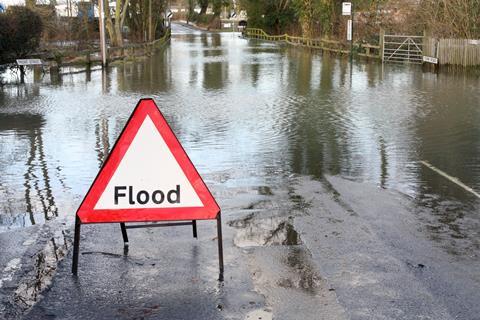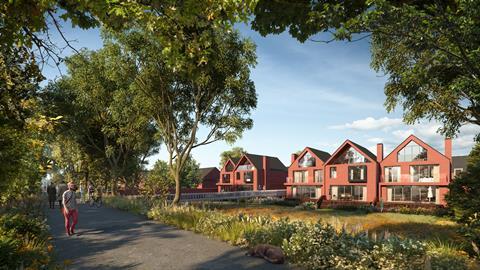Tens of thousands of new homes could become uninsurable in the event of flooding
The government is under pressure to change building regulations to ensure that new homes can withstand floods. Official figures show that one in 10 new homes is built on a site at risk of flooding.

The calls for change come amid accusations from architects that the government has done nothing to prioritise flood resilience of new homes, despite increasingly regular winter floods that affect thousands of properties.
Last week Conservative think-tank Bright Blue said as many as 70,000 homes built since 2009 were at risk of becoming uninsurable due to potential flooding.
Andrew Forth, director of policy at architects’ body Riba said there was a “fundamental need for a complete re-evaluation of building regulations” to ensure homes in at risk areas could withstand flooding.
He said: “We know how to build things that are resilient, that can be put back in to use rapidly after floods. Just building the same in flood risk areas as we build everywhere else isn’t going to get us sustainable homes built.”
Richard Coutts, director of architect practice Baca and adviser to the government on flood risk, said homes planned for areas categorised as high risk – flood zone 3 or borderline zone 2-3 – should see specific building regulations stipulations kick in to ensure flood resilience measures.
These could include measures from positioning electrical points above expected flood levels and using resilient materials, to attaching plasterboard horizontally so lower panels can be replace easily if damaged by water. “It’s not enough to just put a swale round a home – the construction method has to be robust,” he said.
Last week Bright Blue recommended that all new-build properties in flooding zones 2 and 3 should have property-level flood resilience measures.
The calls come after two weeks of storms that have left over a thousand homes flooded, with some areas experiencing the highest rainfall in 200 years.
Currently national planning policy strongly discourages residential development in areas of flood risk, however it does not rule it out entirely. With many towns and cities located on rivers, much of the most attractive sites have some flood risk, making development in areas of flood risk unlikely to stop.
Government land use change data suggests that still around 10% of new homes built each year are sited in areas of high flood risk, yet there are no official standards governing how developers mitigate flood risk in these areas or make homes resilient when flooding does occur.

In 2018 Riba published a detailed study into mitigating the impact of flooding on new build and existing properties, including a five-point list of recommendations for government action, including reform of regs.
But Riba’s Andrew Forth said no significant progress had been made on any of the recommendations. “The government is just not really prioritising this,” he added.
”It’s a lot easier for a politician to put on a hard hat and build a flood defence than it is to make changes to building regulations which ultimately might make more of a difference.”
Baca Architects’ Coutts said the government had pushed back on the idea of tighter building regulations because it said it wanted to see less regulation, not more. However, he said the main issue was political cycles, not government appetite.
“When spring comes and the sun comes out this seems to get forgotten. Then the decision makers get shifted in the next reshuffle. The ministerial merry-go-round is preventing important decisions being made.”
Baca Architects is behind an 11-home flood resilient development at Shipton Road, Stratford-on-Avon, due to complete in this spring (visualisation, top, and in flood, below). It is also working on plans with Yorkshire Water and architect Harper Perry for a 350-home flood resilient community in Hull, which is almost entirely situated on the flood plain.












No comments yet